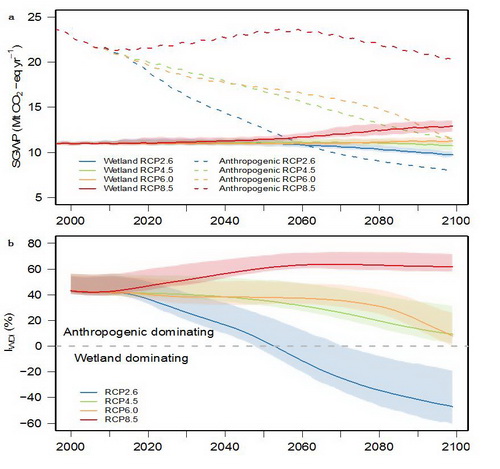
Methane (CH4) emitted from global wetlands has been considered as a major contributor to the variations of atmospheric CH4 concentration over the past 100,000 years. Since the Industrial revolution, atmospheric CH4 concentrations have risen 150%, from the preindustrial level of 715 ppb parts per billion (ppb) to a current concentration of about 1847 ppb with a 2.5-fold increase.
The increase is primarily considered to be driven by anthropogenic activities related to fossil fuel activities, rice cultivation, and ruminant livestock. But as climate-induced warming and changing precipitation pattern continues, the response of global wetlands to climate change feedbacks is becoming increasingly important.
"Wetland CH4 feedback was assumed to be muted in the future climate scenarios in previous climate projection. We use climate and vegetation models to provide a comprehensive assessment and find that climate change could cause shifting dominances of global climate forcing from anthropogenic to wetland CH4 emissions during the 21st century. This highlights the impact of wetland CH4 feedback on global warming." Said Dr. ZHANG Zhen, lead author of a recent publication entitled "Emerging role of wetland methane emissions in driving 21st century climate change".
This study has been done by a research group led by Prof. LI Xin and Prof. HUANG Chunlin at the Northwest Institute of Eco-Environment and Resources of the Chinese Academy of Sciences.
Using the entire future climate projections from 38 climate models for 4 future climate scenarios, the so-called Representative Concentration Pathway (RCP) adopted by the Intergovernmental Panel on Climate Change Fifth Assessment Report (IPCC AR5), the researchers estimated that global wetland CH4 emissions will increase from 172 Tg CH4/yr to between 222-338 Tg CH4/yr in the future RCP scenarios, depending on different climate mitigation scenarios.
If following the assumption in IPCC AR5 to keep the current wetland CH4 emissions balanced by atmospheric sinks but taking into account the increment of wetland CH4 emissions from responses to future warming, the increase in CH4 emissions will translate to an increase in additional global mean radiative forcing of 0.04 Wm-2 to 0.19 Wm-2, the maxima of which is equivalent to one tenth of the surface albedo feedback from climate-change induced melting snow and ice cover.
The researchers developed a hydrological model incorporated within a land surface model to predict changes in wetland areal extent and to investigate how this affects the global wetland CH4 emissions.
They found that tropical wetlands will experience a slight decline in wetland extent in the future, while boreal wetlands will have larger wetland extents for emitting CH4, which are primarily due to shifting precipitation pattern in the Tropics and thawing permafrost in the Arctic respectively.
They proposed that these changes in seasonality of wetland area are indicators for monitoring the long-term dynamics of wetland CH4 emissions at continental-scale.
This study highlights the need to mitigate this additional CH4 from wetlands for limiting global warming to < 2°C and emphasize the need for the policy-relevant temperature targets to incorporate assessment of feedbacks from terrestrial and oceanic system for both CO2 and non-CO2 gases.
The climate forcing signals from wetland CH4 feedbacks will exceed anthropogenic emissions under RCP 2.6, the stringent climate mitigation policies that meet the 2°C target in IPCC AR5 future projection.
In contrast, under the 'worst-case' climate projection RCP 8.5, with no climate mitigation, anthropogenic-driven climatic forcing dominates CH4 radiative forcing throughout the 21st century, resulting in an ~ 0.12±0.01 °C increase in global mean temperature.
Considering the important role of wetland functions in regulating flood control, biodiversity conservation, and CO2 sinks in global environments, converting wetlands into other land cover types is not a good option for mitigation and thus this wetland CH4 feedback is not reversible in short future.
Substantial efforts in the development of mitigating the CH4 emissions from the expansion of agriculture and reduction in fossil fuel-related emissions should be considered and accelerated in climate policy aiming at the 2°C target.

Evolving pattern of wetland and anthropogenic CH4 change over varying time horizon since 1765 using simple sustained pulse-response model. (A) Time series of SGWP for wetland and anthropogenic CH4 emissions. (B) Comparison of RF dominance between wetland and anthropogenic sources. Shaded areas represent the upper and lower range of wetland estimates. Here the SGWPs from wetland and anthropogenic emissions were calculated as ratio of integrated RF of CH4 to RF caused by a pulse emission of an equal mass of CO2 since pre-industrial time (1765). (Image by NIEER)

86-10-68597521 (day)
86-10-68597289 (night)

52 Sanlihe Rd., Xicheng District,
Beijing, China (100864)

